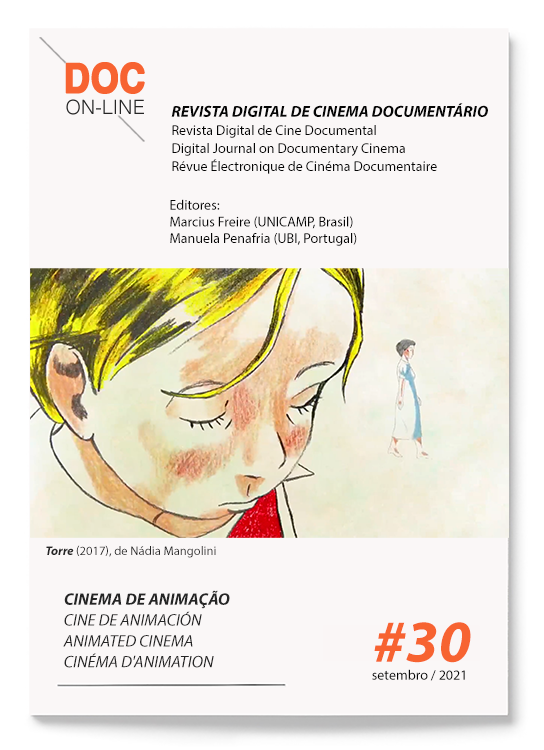John Sutherland e o americanismo: as animações para o Harding College
Mots-clés :
animation, Sutherland, Harding College, américanisme, anticommunismeRésumé
Cet article analyse les neuf documentaires animés produits par John Sutherland pour Harding College entre 1948 et 1952. Guidés par les concepts d’américanisme et d’anticommunisme, ces documentaires glorifient les avantages du système capitaliste et offrent une vision négative du communisme et de ses agents. L’analyse des aspects formels et idéologiques des films partira de la « perspective historique », qui permettra d’approfondir leur relations avec les structures économiques et culturelles de la société dans laquelle ils ont été produits.
Références
Arnold, M. (s.d.). Animating ideas: the John Sutherland story. www.hoganny.com/blog/animating-ideas-the-john-sutherland-story.
Ash, E. (2019, set. 6). Forgotten toons: Hanna-Barbera, anticommunism, and “Make mine freedom” (1948). The Vault of Culture. www.vaultofculture.com/vault/feature/ash/makeminefreedom.
Beauvoir, S. de (2018). Uma existencialista observa os americanos. In S. de Beauvoir, Brigitte Bardot e a síndrome de Lolita e outros escritos (pp. 135-155) (trad. M. Santos & P. Sartori). Quixote + Do Editoras Associadas.
Bogle, L. (2004). The Pentagon’s battle for the American mind: the early Cold War. Texas A & M University Press.
Brianton, K. (2019, ago. 16). Walk east on Beacon. Cinema history. https://cinemahistoryonline.com/2019/08/16/walk-east-on-beacon.
Cohen, K. (s.d.) Animated propaganda during the Cold War: Part two. www.awn.com/animationword/animated-propaganda-during-the-cold-war-parttwo.
Guzmán, P. (2017). Filmar o que não se vê: um modo de fazer documentários (trad. J. Sabino). Edições Sesc São Paulo.
Haas, E., Christensen, T., & Haas, P. (2015). Projecting politics: political messages in American films. Routledge.
Houston, L. (2018). Evangelizing for the American way: the professed mission of Harding, under George S. Benson’s presidency. Tenor o four Times, 7, article 6. https://scholarworks.harding.edu/cgi/viewcontent.cgi?article=1085&context=tenor.
Lewis, T. (2020, fev. 28). National Education Program. CALS, Encyclopedia of Arkansas. https://encyclopediaofarkansas.net/entries/nationaleducation-program-12187/.
Martins, Í. (2009). Documentário animado: experimentação, tecnologia e design. Pontifícia Universidade Católica do Rio de Janeiro.
Mattos, A. (2013). Antropomorfismo na cultura de animação. Instituto de Arte e Comunicação Social/Universidade Federal Fluminense.
Moraes, M. (1999). Simone de Beauvoir e o amor americano (Um tributo a Simone de Beauvoir). Biblioteca Digital da UNICAMP. www.bibliotecadigital.unicamp.br/document/?down=51295.
Neary, N. (2018). Fun and facts about American business: an animated education in the free enterprise system. Northumbria Research Link. http://nrl.northumbria.ac.uk/39992.
Oliveira, O. de (1951, set. 26). Cinema: Fui comunista para o F.B.I. A Manhã.
Ottoni, D. (1950, jun. 27). Cinema: Traidor. Diário Carioca.
Perucci, T. (2012). Paul Robeson and the Cold War performance complex: race, madness, activism. University of Michigan Press.
Quart, L. & Auster, A. (2011). American film and society since 1945. ABCClio.
Rand, A. (1947). Screen guide for Americans. The Motion Picture Alliance for the Preservation of American Ideals.
Robinson, H. (s. d.). The National Education Program on film: highlights from the James D. Bales Project. 365 Mcllroy. https://librariesblog.uark.edu/the-national-education-program-on-film-highlights-from-the-james-d-bales-project/.
S. A. (1949). Freedoms Foundation awards given to fourteen pictures cited for contribution to “American way of life”. Business Screen Magazine, 10(8), 18-19.
S. A. (2014, nov. 1). Ism!. Tralfaz. https://tralfaz.blogspot.com/2014/11/ism.html.
S. A. (2015, jan. 2). A devil of a cartoon. Tralfaz. https://tralfaz.blogspot.com/2015/01/a-devil-of-a-cartoon.html.
S. A. (2020, ago. 8). Why play leap frog?. Tralfaz. https://tralfaz.blogspot.com/2020/08/why-play-leap-frog.html.
S. A.1 (s.d.). I was a Communist for the FBI.Wikipedia. https://en.wikipedia.org/wiki/I_was_a_Communist_for_the_FBI.
S. A.2 (s.d.). Motion Picture Alliance for the Preservation of American Ideals. Wikipedia. https://en.wikipedia.org/wiki/Motion_Picture_Alliance_for_the_ Preservation_of_ American_Ideals.
S. A.3 (s.d.) A song to remember. Wikipedia. https://en.wikipedia.org/wiki/A_Song_to_Remember.
S. A.4 (s.d.). With John Sutherland productions (Stated by popularity ascending). IMBd. www.imdb.com/search/title/?companies=co0025040.
Saunders, F. (2004). La guerra fredda culturale: la CIA e il mondo delle lettere e delle arti. Fazi.
Serra, J. (2011). O documentário animado: quando a animação encontra o cinema do real. USP. www.usp.br/rumores/pdf/rumores10_14_jenifer.pdf.
Serra, J. (2017). A vida animada: (re)construções do mundo histórico através do documentário animado. Instituto de Arte/Unicamp.
Tohline, A. (2009). “Around the corner”: how Jam Hardy’s films reflected and shaped the 1930s and beyond. School of Film/Ohio University.
Whitfield, S. (1996). The culture of the Cold War. The John Hopkins University Press.
Filmografia
Round and Round (1939), da Jam Hardy Organization.
Make mine freedom (1948), de William Hanna e Joseph Barbera (sem créditos).
Going places (1949), de John Sutherland (atribuído). Meet King Joe (1949).
Why play leap frog? (1949), de George Gordon (atribuído).
Albert in Blunderland (1950), de George Gordon (atribuído).
Fresh laid plans (1951), de George Gordon.
Inside Cackle Corners (1951), de George Gordon e Carl Urbano.
The Devil and John Q. (1951), de Carl Urbano.
Dear Uncle (1952), de Carl Urbano.
Téléchargements
Publiée
Numéro
Rubrique
Licence

DOC Online adopte une licence Creative Commons International CC BY 4.0 qui permet le partage du travail avec la reconnaissance de l'auteur et la publication initiale dans la révue DOC On-line, cela signifie que:
1) En soumettant un article, les auteurs conviennent que les droits de première publication de leur travail sont attribués à Doc On-line;
2) Après la publication en DOC On-line les auteurs peuvent republier leurs travaux, en ligne ou imprimée, sous la condition de clairement mentionner la première édition en DOC On-line.

